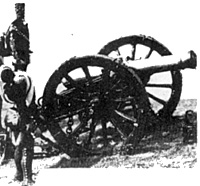 Talking Wargaming
Talking Wargaming
What is the realistic way to deal with casualties to gun crews in the Horse-and-Musket period? To what extent could riflemen for instance, replace the gun numbers on a 12-pdr? How many extra artillerymen were taken into battle to replace casualties? My own view is that gunnery was even then a specialised matter and I therefore treat each casualty to a gun crew as a depletion of one fifth of its effectiveness (in terms of casualties inflicted by its firing) and when all five are down I regard the battery it represents as being out of action. Troops of other arms can wheel the gun away in order to save it from actual capture or spiking by the enemy. The only exception to this is for Gatling in the late l9th century where I allow the crew to be replaced by other infantrymen (it was I think an infantry weapon) but increase the chance of it jamming. Accounts of the Gordon relief expedition to the Sudan certainly indicate that the operation of the Gardner gun was a closed mystery to all but its Naval crew! Rule of the Month Repulsion of Cavalry by Infantry in Line or Square
Although contemporary reports indicated that there was a slight possibility that an infantry line heavier then two-deep could possibly repel cavalry during the Napoleonic Wars, there was always the flaw that the cavalry would overlap and turn the flanks. The infantry square was a heavy infantry line 4 to 6 ranks deep with nrotected flanks. Horses, disliking to step on a prone man and refusing to charge into a solid obstacle would not push into a bayonet fringed solid looking wall of unyielding infantry so that the cavalry tended to swerve round this "island".
When attacking a line cavalry were forced into its centre because there was no place to swerve so as to avoid impact. Providing the line did not look too solid the horses would go forward so that the 3-deep line was the very minimum depth giving them the slightest chance of warding off cavalry. Thus at Salamanca, Ferrey deployed 7 battalions in a 3-deep line with a battalion in square on each flank. In a wargame, providing that its morale is high, a square should be almost invulnerable to a cavalry charge but an infantry line should be far more vulnerable,, to an extent that depends upon their morale and the results of their fire upon the approaching cavalry. Only a short melee with cavalry should take place against a square, but when cavalry make contact with a line the resulting melee could be more prolonged.
Back to Table of Contents -- Wargamer's Newsletter #143
To Wargamer's Newsletter List of Issues
To MagWeb Master Magazine List
© Copyright 1974 by Donald Featherstone.
This article appears in MagWeb (Magazine Web) on the Internet World Wide Web.
Other military history articles and gaming articles are available at http://www.magweb.com